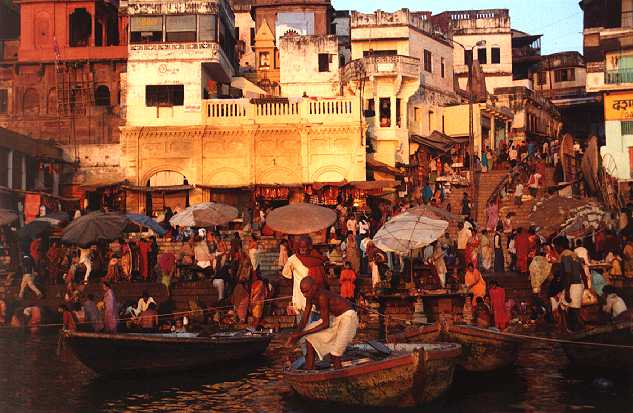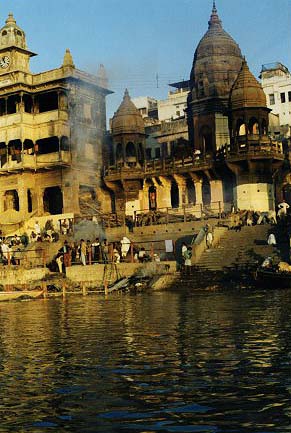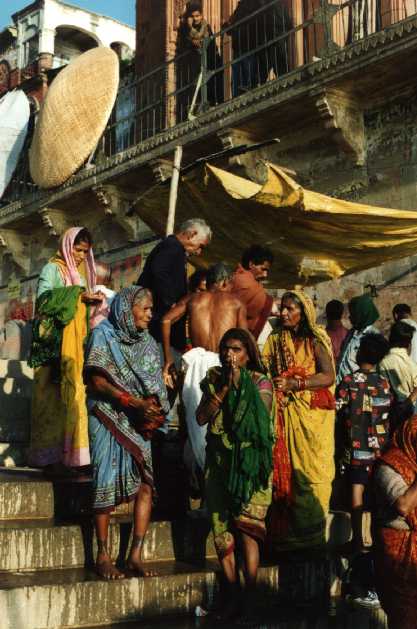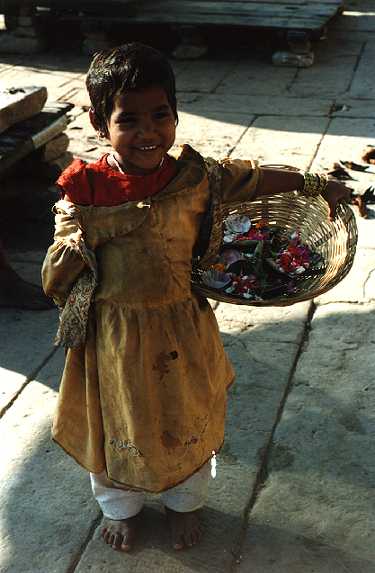
 Thursday, November 14:
Thursday, November 14:As promised, we were up before dawn. Our hotel wouldn't be serving breakfast til 7:30am, so we decided to hit the Ganges and worry about nourishment later. Once we descended the hotel steps, we were approached by numerous boatmen offering their services at around 30 rupees (90 cents) per hour. I bargained with one of them down to 20 rupees, so we climbed aboard. We were joined by an Irishmen from Belfast who was on a six-month journey of enlightenment (he was a follower of kundalini yoga and Gurdjieff's Fourth Way movement, apparently).
The sunrise itself was pleasant, but our real interest was aimed at the ghats on the western banks of the Ganges. Varanasi has over 100 ghats, each with their own style and eccentricities. Hundreds of people were in the Ganges along the ghats, bathing and drinking - a true act of faith, I thought, considering that Ma Ganga is perhaps the filthiest and most toxic river in the world. The most crowded point was at the main ghat, Desaswamedh Ghat:

 At the cremation ghats, right below our hotel, corpses draped in shawls were lined up to be burnt, their ashes to be shoveled into the Ganges after three hours of immolation. To die and be cremated at Varanasi was a great honor for Hindus, many of whom believe that ending one's life here allows one's spirit to proceed directly to heaven, without having to deal with karma and the inevitable reincarnations that occur because of it. The bodies of sadhus, however, chose another path to Nirvana. Certain sects of Sadhus believe they can't be cremated like other Hindus, so instead they are simply wrapped up like a mummy in silk and set adrift down river. Our boat occasionally bumped into one of these cadavers on its final journey. Rigor mortis had run its course and the corpse would often have an arm aimed upwards as if pointing to the sky. Our boatman would give them a bit of a shove with an hour any time one started to bang into the boat. They all looked like manikins wrapped in linens, which made it a bit easier to deal with the fact that we were attempting to enjoy a relaxing ride down India's river of death.
At the cremation ghats, right below our hotel, corpses draped in shawls were lined up to be burnt, their ashes to be shoveled into the Ganges after three hours of immolation. To die and be cremated at Varanasi was a great honor for Hindus, many of whom believe that ending one's life here allows one's spirit to proceed directly to heaven, without having to deal with karma and the inevitable reincarnations that occur because of it. The bodies of sadhus, however, chose another path to Nirvana. Certain sects of Sadhus believe they can't be cremated like other Hindus, so instead they are simply wrapped up like a mummy in silk and set adrift down river. Our boat occasionally bumped into one of these cadavers on its final journey. Rigor mortis had run its course and the corpse would often have an arm aimed upwards as if pointing to the sky. Our boatman would give them a bit of a shove with an hour any time one started to bang into the boat. They all looked like manikins wrapped in linens, which made it a bit easier to deal with the fact that we were attempting to enjoy a relaxing ride down India's river of death.
After an hour or so of floating in front of the ghats, we disembarked near our hotel, back at Scindia ghat. It was still well before 7am, so we decided to walk down to Desaswamedh Ghat. Our first stop was the the cremation ghat. It was quite a contrast from the evening before - only a handful of cremations were going on, and the crowd participating in the rituals was significantly smaller. But since this was Susanne's first visit, she was still amazed at the sight of burning bodies being swept into the water. I guess I was spoiled by a good night out on the town.
Once we got our fill of smoke, we continued onward to Desaswamedh Ghat. It probably had more merchants than bathers at this point, who were offering massages, shaves, haircuts, fortunes, and other services to people as they arrived to bathe. Some overanxious guy grabbed my hand and started to rub it, smiling and saying, "Good massage? Ten rupees!" I wasn't pleased.
 We then climbed the steps to the large open market that extends all the way into Gadaulia towards the New City. There were hundreds of locals buying and selling fresh fruits and vegetables, as well as chickens, pet parakeets, and other animals. Susanne and I spent some time photographing people. It was a colorful sight, with so many women in bright saris, as the sun sprayed its beams just at the right angle for us to get the perfect shot. Another busy morning in Benares.
We then climbed the steps to the large open market that extends all the way into Gadaulia towards the New City. There were hundreds of locals buying and selling fresh fruits and vegetables, as well as chickens, pet parakeets, and other animals. Susanne and I spent some time photographing people. It was a colorful sight, with so many women in bright saris, as the sun sprayed its beams just at the right angle for us to get the perfect shot. Another busy morning in Benares.
Our next goal was to find a safe spot for breakfast, but after having walked all the way through Gadaulia and back, we figured out that no restaurants opened before 9am. This meant we'd have to kill another hour before we could fill our stomachs. The time was spent easily on the ghats south of Desaswamedh. They were less crowded than the ghats further north, but were still quite interesting, as they attracted few tourists and therefore felt less commercialized.
Soon enough, our hour had passed, so we returned yet again to Gadaulia for breakfast at Ace's New Deal Restaurant. The only person working at this shabby place was a small old man - he must be Ace. We ate french toast and tea, and talked with an American couple that happened to be from DC as well. They caught us up on the week's news - namely, a collision between two planes over New Delhi, two days after we arrived (I'm sure that really pleased both of our parents). They also strongly recommended the Utse Hotel for our stay in Kathmandu. I had read that it had one of the best restaurants in town, so I made a mental note of it. As we talked, the four of us noticed that inside the cafe's courtyard was a freshly severed goat's head next to a small Shiva shrine. Nothing like an early morning sacrifice to get yourself hungry, I suppose.
 We returned to the Old City and began to meander through its many alleyways. One curio stall followed another, most of them offering similar, if not the exact same souvenirs. We tried to go into the Hindu Golden Temple and the Mosque of Aurangzeb that stood next to it. Originally, the Golden Temple stood for over 1000 years at the spot where the Mosque now stands, but Aurangzeb, being the intolerant zealot he was, razed the place while tearing across the Ganges on one of his anti-Hindu raids, and then added insult to injury by building this magnificent Mosque on top of it. The Hindu population eventually rebuilt their temple next store, and there's been an army presence in the neighborhood for decades to keep the two sides from stirring things up again. But because it was one of the last days of Diwali, the army presence had been beefed up, and only Hindus and Muslims were allowed to step into either house of worship that week. We had no choice but to appreciate the views from the outside.
We returned to the Old City and began to meander through its many alleyways. One curio stall followed another, most of them offering similar, if not the exact same souvenirs. We tried to go into the Hindu Golden Temple and the Mosque of Aurangzeb that stood next to it. Originally, the Golden Temple stood for over 1000 years at the spot where the Mosque now stands, but Aurangzeb, being the intolerant zealot he was, razed the place while tearing across the Ganges on one of his anti-Hindu raids, and then added insult to injury by building this magnificent Mosque on top of it. The Hindu population eventually rebuilt their temple next store, and there's been an army presence in the neighborhood for decades to keep the two sides from stirring things up again. But because it was one of the last days of Diwali, the army presence had been beefed up, and only Hindus and Muslims were allowed to step into either house of worship that week. We had no choice but to appreciate the views from the outside.
Susanne wanted to get an up-close look at a Hindu temple, so we decided to return to the ghats and walk south to Asi Ghat, which was close to Varanasi's so-called Monkey Temple, the temple of Durga. Apparently having underestimated the distance to Asi Ghat, I admitted after 45 minutes of walking that it might be a good idea to hire a boat. All we had to do was pause and look out over the Ganges, and in a matter of seconds, we had boatmen trying to get our attention.
 Our boatman, Bhapu, was really a boatboy - I'd guess he was around 13 or 14. His hands and feet were covered with the thick callouses that were the badge of a veteran in his profession. Overall, Bhapu was very quiet, but he would occasionally break out into a question about us, our trip, or where we were from. We eventually arrived at Asi Ghat about 30 minutes later. When we reached the ghat, Bhapu offered to take us to the Durga temple. Obviously, he wasn't doing this out of the kindness of his heart, but our map didn't include this end of town, so I figured it was worth a few extra rupees to get a walking navigator to guide us. In hindsight, we made a wise choice in hiring him. The LP map was of no use whatsoever, as I had feared. It was only a 15 minute walk to the temple, but the trip required a lot of lefts and rights that I would have never thought of following. We passed by what Bhapu said was his uncle's shop. Aha, I thought - he's hoping we'll want to shop. Over my dead body...
Our boatman, Bhapu, was really a boatboy - I'd guess he was around 13 or 14. His hands and feet were covered with the thick callouses that were the badge of a veteran in his profession. Overall, Bhapu was very quiet, but he would occasionally break out into a question about us, our trip, or where we were from. We eventually arrived at Asi Ghat about 30 minutes later. When we reached the ghat, Bhapu offered to take us to the Durga temple. Obviously, he wasn't doing this out of the kindness of his heart, but our map didn't include this end of town, so I figured it was worth a few extra rupees to get a walking navigator to guide us. In hindsight, we made a wise choice in hiring him. The LP map was of no use whatsoever, as I had feared. It was only a 15 minute walk to the temple, but the trip required a lot of lefts and rights that I would have never thought of following. We passed by what Bhapu said was his uncle's shop. Aha, I thought - he's hoping we'll want to shop. Over my dead body...
We reached the Durga temple, a bright, shiny, ochre-red structure which stood next to a large reflecting pool. The LP guide said that non-Hindus weren't allowed inside it (non-Hindus rarely are anywhere in the subcontinent), but Bhapu insisted we come inside. "No problem, no problem," he said. We left our shoes with some Dalit who were begging outside. Bhapu promised that a couple of rupees would guarantee their safety until our return.
Once inside, the Durga temple felt like a small place - I would guess it was no more than 50 feet square, with a large shrine occupying the space in the middle. Everything was gleaming red. The color was nothing like the Agra sandstone red we had seen earlier in the trip - this red made the temple look like polished chrome, dripping with fresh, shiny paint. I was almost afraid to touch anything, lest my hands would get smeared by it. On the shrine in the center, a group of monkeys were hanging out. Bhapu warned us to hold our cameras tightly just in case one of them made a move on us.
At the bottom of the central shrine was a statue of Durga, a powerful Hindu goddess who basically represents peace through strength. She is a fierce warrior who has collected the best weapons from all of the gods, so she serves as a deterrent and protector. To quote one of her myths, she deals with her enemies like Bruce Lee-like skill:
With her bell she confused the demons, and many were dragged away bound and chained. With her divine sword she cut them to bits. So many demons and elephants and horses died that a river of blood flowed across the battlefield. The ground was left littered with the broken limbs and body parts of the defeated demon army. Durga was then attacked by the demon commanders, who were all killed immediately, and without mercy.
A small woman approached us from in front of the statue. She didn't seem very pleased that we were there, so Bhapu told us to hand ten rupees to her assistant, an old man. I did, and as soon as he had his hands on our money, her visage changed to an enormous smile. Before we knew what was going on, she pressed her fingers into our foreheads, leaving a bright red tika mark above our noses. She also placed garlands of orange flowers around our necks. It was the last day of Diwali, and during the festival, one is supposed to get a fresh tika mark, so at least we were getting to participate in our own small way. Susanne said my tika looked like a Nike check mark. Can't wait to see the picture.
We spent another ten minutes in the temple, then recovered our shoes and had a walk by a large marble temple down the street. We had thought about catching an autorickshaw from there to Sarnath, the garden where Buddha first preached his path to enlightenment, but instead we chose to return with Bhapu to Desaswamedh Ghat, where we'd climb up and get lunch somewhere first. Bhapu tried to get us to stop at his uncle's silk shop, but we declined. He was pretty quiet after that, and even though we gave him a sizable tip after he dropped us off at Desaswamedh, he seemed annoyed, as if we were supposed to shower him with thousands of rupees or something.
Susanne and I ate at Keshari's, which supposedly had the best vegetarian food in Varanasi. I had a thali platter while Susanne stuck with her usual masala dosa. Because the restaurant was so full when we arrived, the waiter placed us at a table with a young couple from England. Even though we're usually pretty good at striking up conversations with fellow travellers, for some reason we ran out of things to say to each other quickly. Good thing the food arrived, so we could mask our lack of anything to say by eating ravenously. From Keshari's, we then went outside and caught a rickshaw to Sarnath. I had hoped to bargain down from the quoted round-trip price of 100 rupees, but every rickshaw-wallah we found said, "100 is fixed price, no bargain." It was a conspiracy, so we had no choice but to spend the three bucks.
The ride to Sarnath took a good 40 minutes, but as far as I could tell, it could have been hours. We rode through the most congested and dirtiest part of Varanasi, and the smoke and dust was so thick I could almost feel myself developing black lung disease or something. We spent the ride breathing through our shirts just in case. Fortunately, the bad air thinned out as we reached the outskirts of the city and into the grassy lands of Sarnath. When we arrived, the driver agreed to meet us in an hour. That should be plenty of time for us to look around - Sarnath is now a large green park with some ruins scattered about. Besides that, it's really just a place to take a walk.
The main sights at Sarnath included an Ashokan pillar, raised by the first great Indian Emperor over 2000 years ago. In the time since, though, the pillar had collapsed and as much of it laid there in stump-like pieces, it didn't possess the magic and power I would have expected from one of Ashoka's few lasting relics. About 100 yards away was the large stone stupa of Sarnath, a massive brick cylinder that looked like the world's biggest thimble. The stupa marked the spot where Buddha himself first publicly preached his message of the eight-fold path to enlightenment. Now it was a worn slab of rock with a fence around it.
We lounged for a bit in the grass, but a group of schoolkids were sitting there, staring at us the entire time. After 15 minutes of feeling quite awkward about it, we got up and started to walk again. We heard some chanting behind the ruins near the Ashokan pillar. A group of pilgrim tourists from Thailand were lighting candles and praying. They were all dressed in white, apart from their guide, a Buddhist monk with red and yellow robes and a shaved head. He was also sporting a battery-powered bullhorn, which he used to guide the group from place to place. Further down the path, another robed monk, an older man, was sitting in the middle of the foundation of a round shrine. There was a 'Do not tread on ruins' sign next to it. The monk was meditating, his eyes open and fixed on some point in space. I quickly imagined him with a group of other monks, using ESP to talk about Lotus Notes, as in that IBM commercial. Sacrilege.
Our allotment of time had passed, so we headed out to find our driver. After shoving away some tout who was following us, I realized to my embarrassment that he was actually our driver, and that I had forgotten what he looked like. I guess I'd have to increase the tip. The ride back to Old Town was more tolerable than the way out - I knew to keep my shirt over my mouth as soon as we left the countryside. I expected to see a big black blotch over the part of the cloth I was breathing through. No wonder the life expectancy here is only 58. If they could only find an affordable way to switch to unleaded, this country would be a much cleaner place.
It was now past 3pm, and the sun was dipping lower on the horizon. We decided to visit the ghats again to take more pictures. The number of bathers hadn't decreased at all around Desaswamedh Ghat; in fact, there were probably even more people out washing their clothes in the river, and then beating the water out of them by flailing them into large rocks. We eventually returned to the hotel and had some tea on the roof terrace. John, the errant New Yorker, his unnamed Korean friend, and two Danish women were there enjoying the twilight. As the sun set, hundreds of swifts began their daily ritual of gliding overhead, picking off flies and moths to their hearts' content.
Once it was dark, Susanne, John, the Korean guy and I decided to go for dinner at the Ganga Fuji restaurant, where, as John said, "the food is adequate, the service is awful, but there's live sitar music." Indeed, he was correct, but he neglected to mention that the music was pretty awful as well. I probably could have played sitar better than this guy. I also made my first major eating mistake of the trip by ordering this weird curried cheese dish. "House specialty," the waiter said. My foot. I would later regret listening to him.
John and Mr. Korean provided comic relief. John talked endlessly, but he was always interesting and funny. He had taught English in Japan for four years, and had just arranged a leave of absence from his school in New York, where his cranky boss almost didn't let him go ("To call this boss a bitch would be... too simple, I suppose..." he moaned). Meanwhile, our anonymous Korean friend was oblivious in his own world, making shapes out of the cheap straws at the table. At one point, he actually fashioned a huge oxen's nose ring out of one and shoved it in his nose for at least 10 minutes, staring into space as if he were completely detached from reality. It was quite funny.
As we returned to the hotel through the alleys, there was a blackout. We couldn't see a thing in front of us, and I didn't care for the idea of manouvering blindly through the twists, turns, steps, and cows. I managed to slip and slide only once, though, before Korean Guy saved the day by leading us with his cigarette lighter. A walking statue of liberty guiding us tired and poor across the debris and dung.
From Scindia Ghat, we could see that our hotel was alight. Despite its shortcomings, the Scindia Guest House at least was smart enough to have its own power generator - a very wise investment. Tomorrow was to be our travel day to Kathmandu, so we hit the sack around 9pm. Soon thereafter, though, I began to feel a lump in my lower throat, growing and growing. The cheese curry, it appeared, was doing me in. I never actually got sick that night, but I spent much of the evening running into the bathroom, praying that I would. Nothing ever happened, apart from a few painful burps that relieved much of the pressure. I took a couple of Tylenol PMs and some Peptos and managed to get some sleep.
Take me back to the journal index.
Take me back to Andy's Waste of Bandwidth.


